dimensions Alfa Romeo Stelvio 2019 Owner's Manual
[x] Cancel search | Manufacturer: ALFA ROMEO, Model Year: 2019, Model line: Stelvio, Model: Alfa Romeo Stelvio 2019Pages: 244, PDF Size: 4.95 MB
Page 77 of 244
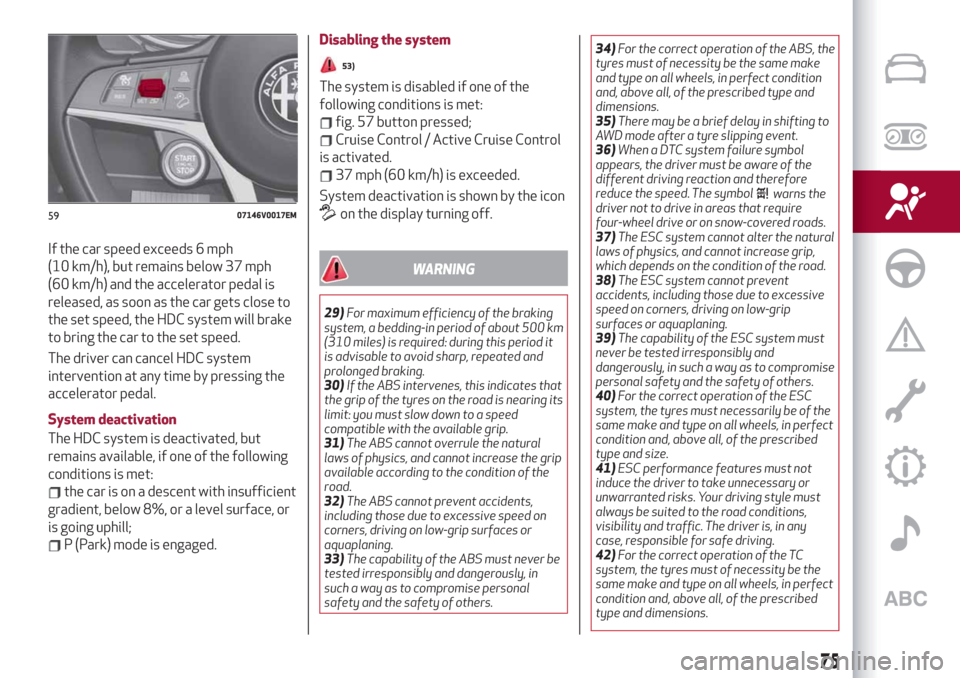
If the car speed exceeds 6 mph
(10 km/h), but remains below 37 mph
(60 km/h) and the accelerator pedal is
released, as soon as the car gets close to
the set speed, the HDC system will brake
to bring the car to the set speed.
The driver can cancel HDC system
intervention at any time by pressing the
accelerator pedal.
System deactivation
The HDC system is deactivated, but
remains available, if one of the following
conditions is met:
the car is on a descent with insufficient
gradient, below 8%, or a level surface, or
is going uphill;
P (Park) mode is engaged.Disabling the system
53)
The system is disabled if one of the
following conditions is met:
fig. 57 button pressed;
Cruise Control / Active Cruise Control
is activated.
37 mph (60 km/h) is exceeded.
System deactivation is shown by the icon
on the display turning off.
WARNING
29)For maximum efficiency of the braking
system, a bedding-in period of about 500 km
(310 miles) is required: during this period it
is advisable to avoid sharp, repeated and
prolonged braking.
30)If the ABS intervenes, this indicates that
the grip of the tyres on the road is nearing its
limit: you must slow down to a speed
compatible with the available grip.
31)The ABS cannot overrule the natural
laws of physics, and cannot increase the grip
available according to the condition of the
road.
32)The ABS cannot prevent accidents,
including those due to excessive speed on
corners, driving on low-grip surfaces or
aquaplaning.
33)The capability of the ABS must never be
tested irresponsibly and dangerously, in
such a way as to compromise personal
safety and the safety of others.34)For the correct operation of the ABS, the
tyres must of necessity be the same make
and type on all wheels, in perfect condition
and, above all, of the prescribed type and
dimensions.
35)There may be a brief delay in shifting to
AWD mode after a tyre slipping event.
36)When a DTC system failure symbol
appears, the driver must be aware of the
different driving reaction and therefore
reduce the speed. The symbol
warns the
driver not to drive in areas that require
four-wheel drive or on snow-covered roads.
37)The ESC system cannot alter the natural
laws of physics, and cannot increase grip,
which depends on the condition of the road.
38)The ESC system cannot prevent
accidents, including those due to excessive
speed on corners, driving on low-grip
surfaces or aquaplaning.
39)The capability of the ESC system must
never be tested irresponsibly and
dangerously, in such a way as to compromise
personal safety and the safety of others.
40)For the correct operation of the ESC
system, the tyres must necessarily be of the
same make and type on all wheels, in perfect
condition and, above all, of the prescribed
type and size.
41)ESC performance features must not
induce the driver to take unnecessary or
unwarranted risks. Your driving style must
always be suited to the road conditions,
visibility and traffic. The driver is, in any
case, responsible for safe driving.
42)For the correct operation of the TC
system, the tyres must of necessity be the
same make and type on all wheels, in perfect
condition and, above all, of the prescribed
type and dimensions.
5907146V0017EM
75
Page 83 of 244

vehicles with small dimensions and/or
not aligned in the driving lane;
lane change by other vehicles;
vehicles travelling at right angles to
the vehicle.
system intervention might be
unexpected or delayed. The driver must
therefore be very careful, keeping
control of the vehicle to drive in complete
safety.
IMPORTANT In particularly complex
traffic conditions, the driver can
deactivate the system manually through
the Connect system.
Driving close to a bend
When entering or leaving a wide bend, the
system may detect a vehicle that is in
front of you, but that is not driving in the
same lane fig. 64. In cases such as these,
the system may intervene.The vehicle ahead is leaving a
roundabout.
On a roundabout, the system could
intervene when it detects a vehicle ahead
that is leaving the roundabout fig. 65.
Vehicles with small dimensions and/or
not aligned in the driving lane
The system cannot detect vehicles in
front of the car if they are outside the
range of the radar sensor or may not
react to small vehicles, such as bicycles
or motorcycles fig. 66.Lane change by other vehicles
Vehicles suddenly changing lane to enter
the same lane as your car within the
operating range of the radar sensor, may
cause the system to intervene fig. 67.
6406016V0005EM
6506016V0010EM
6606016V0006EM
6706016V0007EM
81
Page 85 of 244
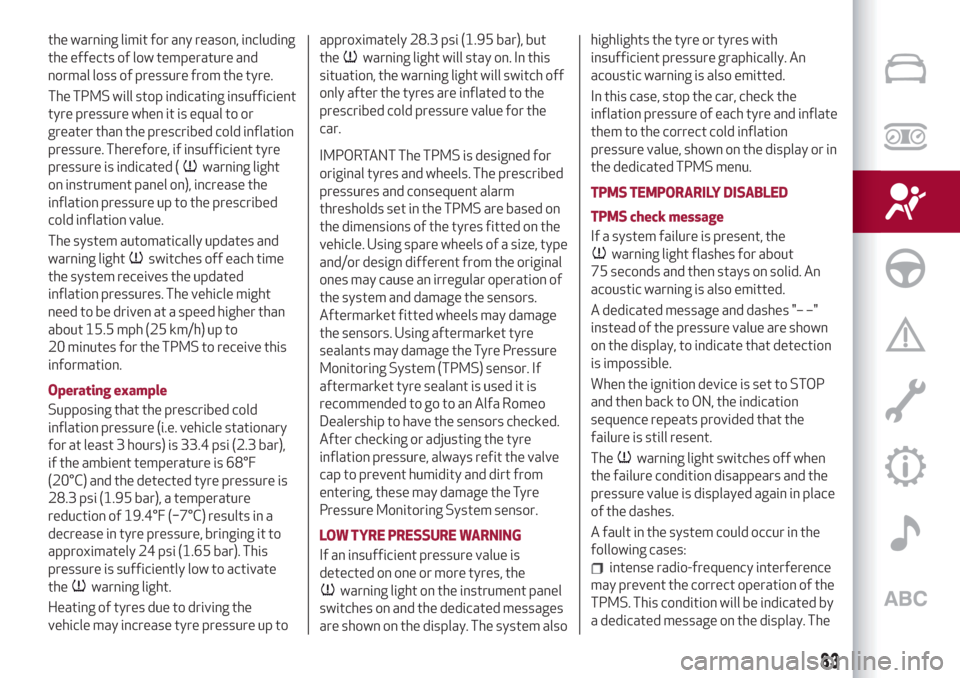
the warning limit for any reason, including
the effects of low temperature and
normal loss of pressure from the tyre.
The TPMS will stop indicating insufficient
tyre pressure when it is equal to or
greater than the prescribed cold inflation
pressure. Therefore, if insufficient tyre
pressure is indicated (
warning light
on instrument panel on), increase the
inflation pressure up to the prescribed
cold inflation value.
The system automatically updates and
warning light
switches off each time
the system receives the updated
inflation pressures. The vehicle might
need to be driven at a speed higher than
about 15.5 mph (25 km/h) up to
20 minutes for the TPMS to receive this
information.
Operating example
Supposing that the prescribed cold
inflation pressure (i.e. vehicle stationary
for at least 3 hours) is 33.4 psi (2.3 bar),
if the ambient temperature is 68°F
(20°C) and the detected tyre pressure is
28.3 psi (1.95 bar), a temperature
reduction of 19.4°F (−7°C) results in a
decrease in tyre pressure, bringing it to
approximately 24 psi (1.65 bar). This
pressure is sufficiently low to activate
the
warning light.
Heating of tyres due to driving the
vehicle may increase tyre pressure up toapproximately 28.3 psi (1.95 bar), but
the
warning light will stay on. In this
situation, the warning light will switch off
only after the tyres are inflated to the
prescribed cold pressure value for the
car.
IMPORTANT The TPMS is designed for
original tyres and wheels. The prescribed
pressures and consequent alarm
thresholds set in the TPMS are based on
the dimensions of the tyres fitted on the
vehicle. Using spare wheels of a size, type
and/or design different from the original
ones may cause an irregular operation of
the system and damage the sensors.
Aftermarket fitted wheels may damage
the sensors. Using aftermarket tyre
sealants may damage the Tyre Pressure
Monitoring System (TPMS) sensor. If
aftermarket tyre sealant is used it is
recommended to go to an Alfa Romeo
Dealership to have the sensors checked.
After checking or adjusting the tyre
inflation pressure, always refit the valve
cap to prevent humidity and dirt from
entering, these may damage the Tyre
Pressure Monitoring System sensor.
LOW TYRE PRESSURE WARNING
If an insufficient pressure value is
detected on one or more tyres, the
warning light on the instrument panel
switches on and the dedicated messages
are shown on the display. The system alsohighlights the tyre or tyres with
insufficient pressure graphically. An
acoustic warning is also emitted.
In this case, stop the car, check the
inflation pressure of each tyre and inflate
them to the correct cold inflation
pressure value, shown on the display or in
the dedicated TPMS menu.
TPMS TEMPORARILY DISABLED
TPMS check message
If a system failure is present, the
warning light flashes for about
75 seconds and then stays on solid. An
acoustic warning is also emitted.
A dedicated message and dashes "– –"
instead of the pressure value are shown
on the display, to indicate that detection
is impossible.
When the ignition device is set to STOP
and then back to ON, the indication
sequence repeats provided that the
failure is still resent.
The
warning light switches off when
the failure condition disappears and the
pressure value is displayed again in place
of the dashes.
A fault in the system could occur in the
following cases:
intense radio-frequency interference
may prevent the correct operation of the
TPMS. This condition will be indicated by
a dedicated message on the display. The
83
Page 190 of 244
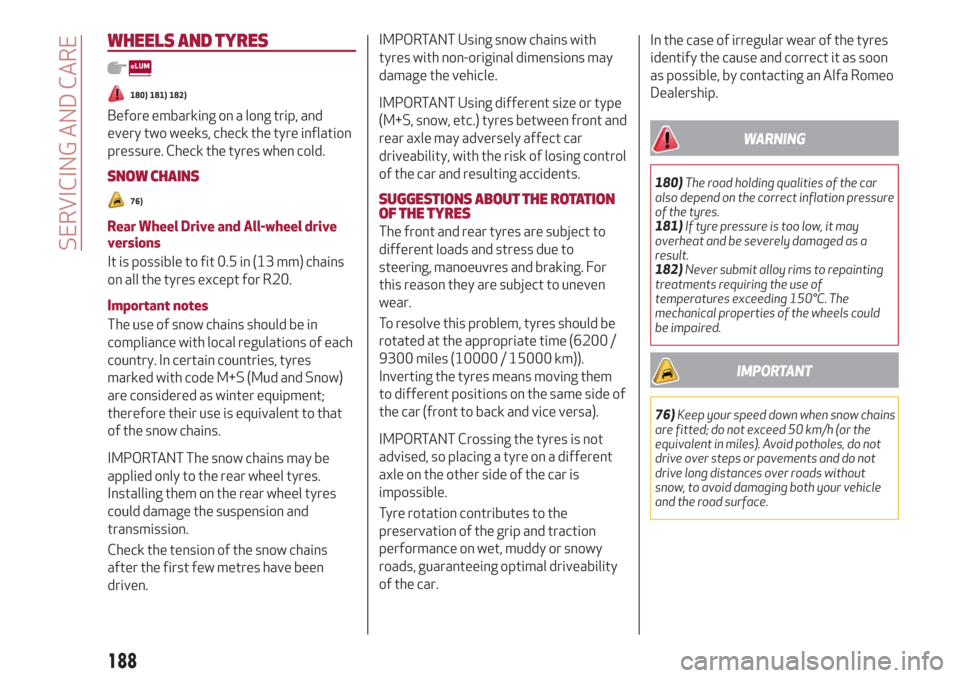
WHEELS AND TYRES
180) 181) 182)
Before embarking on a long trip, and
every two weeks, check the tyre inflation
pressure. Check the tyres when cold.
SNOW CHAINS
76)
Rear Wheel Drive and All-wheel drive
versions
It is possible to fit 0.5 in (13 mm) chains
on all the tyres except for R20.
Important notes
The use of snow chains should be in
compliance with local regulations of each
country. In certain countries, tyres
marked with code M+S (Mud and Snow)
are considered as winter equipment;
therefore their use is equivalent to that
of the snow chains.
IMPORTANT The snow chains may be
applied only to the rear wheel tyres.
Installing them on the rear wheel tyres
could damage the suspension and
transmission.
Check the tension of the snow chains
after the first few metres have been
driven.
IMPORTANT Using snow chains with
tyres with non-original dimensions may
damage the vehicle.
IMPORTANT Using different size or type
(M+S, snow, etc.) tyres between front and
rear axle may adversely affect car
driveability, with the risk of losing control
of the car and resulting accidents.
SUGGESTIONS ABOUT THE ROTATION
OF THE TYRES
The front and rear tyres are subject to
different loads and stress due to
steering, manoeuvres and braking. For
this reason they are subject to uneven
wear.
To resolve this problem, tyres should be
rotated at the appropriate time (6200 /
9300 miles (10000 / 15000 km)).
Inverting the tyres means moving them
to different positions on the same side of
the car (front to back and vice versa).
IMPORTANT Crossing the tyres is not
advised, so placing a tyre on a different
axle on the other side of the car is
impossible.
Tyre rotation contributes to the
preservation of the grip and traction
performance on wet, muddy or snowy
roads, guaranteeing optimal driveability
of the car.In the case of irregular wear of the tyres
identify the cause and correct it as soon
as possible, by contacting an Alfa Romeo
Dealership.
WARNING
180)The road holding qualities of the car
also depend on the correct inflation pressure
of the tyres.
181)If tyre pressure is too low, it may
overheat and be severely damaged as a
result.
182)Never submit alloy rims to repainting
treatments requiring the use of
temperatures exceeding 150°C. The
mechanical properties of the wheels could
be impaired.
IMPORTANT
76)Keep your speed down when snow chains
are fitted; do not exceed 50 km/h (or the
equivalent in miles). Avoid potholes, do not
drive over steps or pavements and do not
drive long distances over roads without
snow, to avoid damaging both your vehicle
and the road surface.
188
SERVICING AND CARE
Page 193 of 244
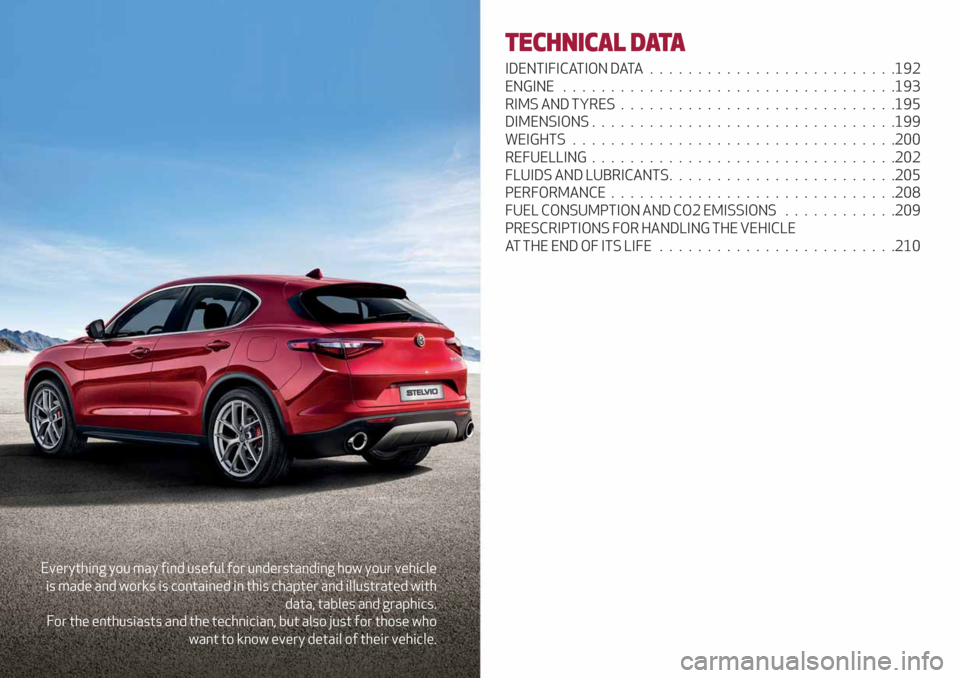
Everything you may find useful for understanding how your vehicle
is made and works is contained in this chapter and illustrated with
data, tables and graphics.
For the enthusiasts and the technician, but also just for those who
want to know every detail of their vehicle.
TECHNICAL DATA
IDENTIFICATION DATA..........................192
ENGINE...................................193
RIMS AND TYRES.............................195
DIMENSIONS . . ..............................199
WEIGHTS..................................200
REFUELLING................................202
FLUIDS AND LUBRICANTS........................205
PERFORMANCE..............................208
FUEL CONSUMPTION AND CO2 EMISSIONS . . ..........209
PRESCRIPTIONS FOR HANDLING THE VEHICLE
AT THE END OF ITS LIFE.........................210
Page 200 of 244
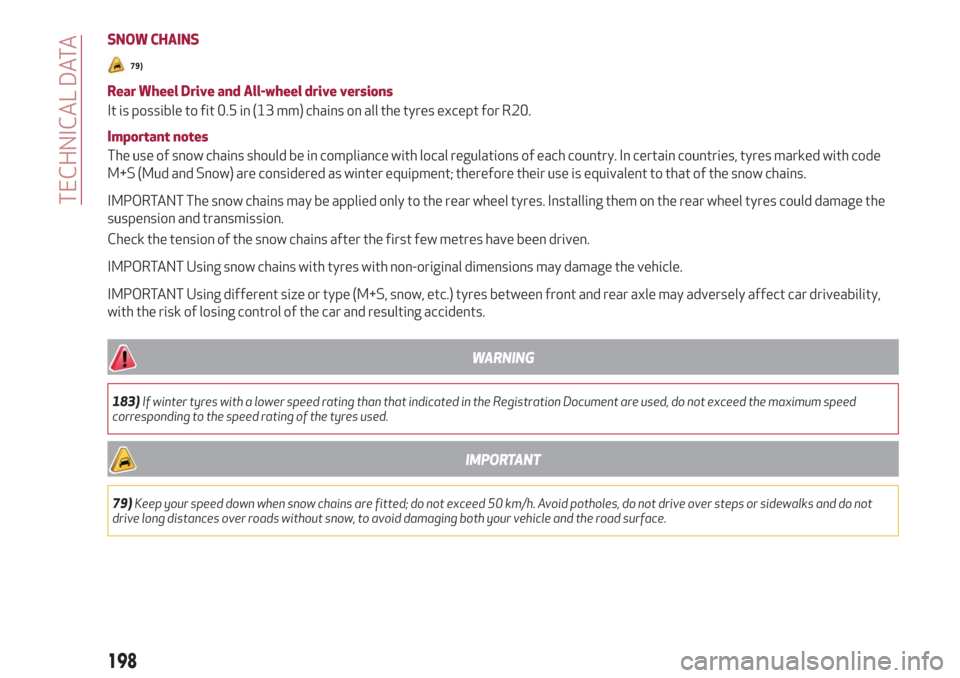
SNOW CHAINS
79)
Rear Wheel Drive and All-wheel drive versions
It is possible to fit 0.5 in (13 mm) chains on all the tyres except for R20.
Important notes
The use of snow chains should be in compliance with local regulations of each country. In certain countries, tyres marked with code
M+S (Mud and Snow) are considered as winter equipment; therefore their use is equivalent to that of the snow chains.
IMPORTANT The snow chains may be applied only to the rear wheel tyres. Installing them on the rear wheel tyres could damage the
suspension and transmission.
Check the tension of the snow chains after the first few metres have been driven.
IMPORTANT Using snow chains with tyres with non-original dimensions may damage the vehicle.
IMPORTANT Using different size or type (M+S, snow, etc.) tyres between front and rear axle may adversely affect car driveability,
with the risk of losing control of the car and resulting accidents.
WARNING
183)If winter tyres with a lower speed rating than that indicated in the Registration Document are used, do not exceed the maximum speed
corresponding to the speed rating of the tyres used.
IMPORTANT
79)Keep your speed down when snow chains are fitted; do not exceed 50 km/h. Avoid potholes, do not drive over steps or sidewalks and do not
drive long distances over roads without snow, to avoid damaging both your vehicle and the road surface.
198
TECHNICAL DATA
Page 201 of 244
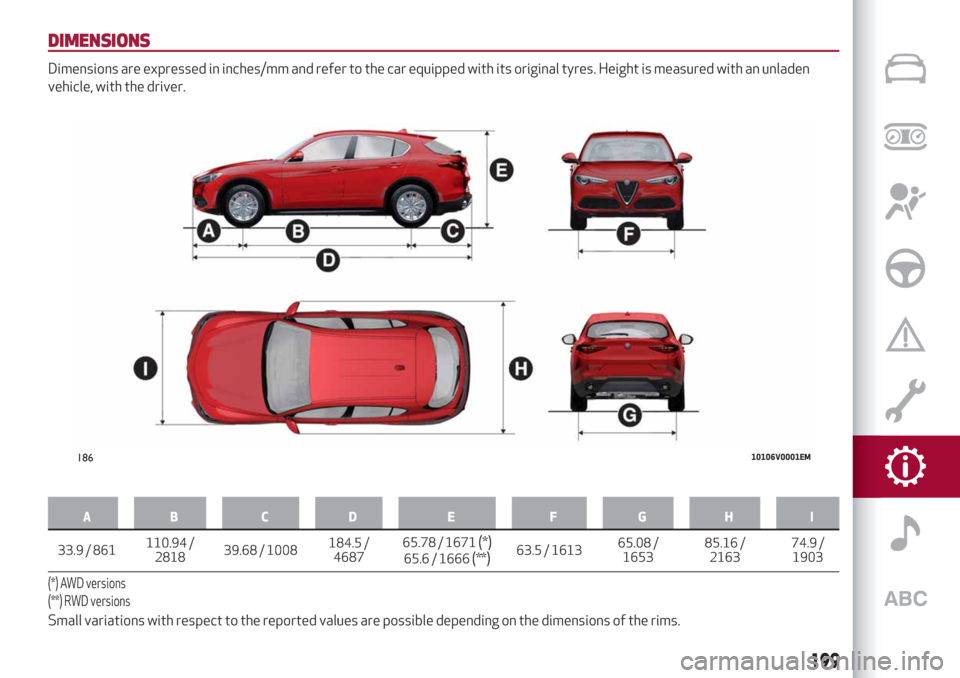
DIMENSIONS
Dimensions are expressed in inches/mm and refer to the car equipped with its original tyres. Height is measured with an unladen
vehicle, with the driver.
AB C D E F GHI
33.9 / 861110.94
/
281839.68 / 1008184.5 /
468765.78 / 1671(*)65.6 / 1666(**)63.5 / 161365.08 /
165385.16 /
216374.9 /
1903
(*) AWD versions
(**) RWD versions
Small variations with respect to the reported values are possible depending on the dimensions of the rims.
18610106V0001EM
199
Page 239 of 244
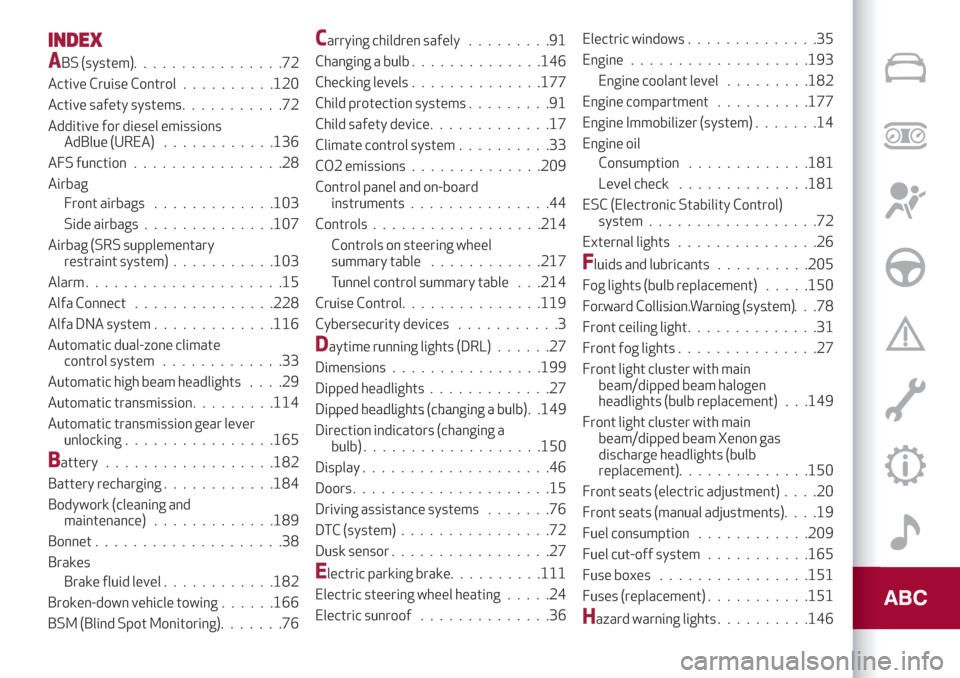
INDEX
ABS (system)................72
Active Cruise Control..........120
Active safety systems...........72
Additive for diesel emissions
AdBlue (UREA)............136
AFS function................28
Airbag
Front airbags.............103
Side airbags..............107
Airbag (SRS supplementary
restraint system)...........103
Alarm.....................15
Alfa Connect...............228
Alfa DNA system.............116
Automatic dual-zone climate
control system.............33
Automatic high beam headlights....29
Automatic transmission.........114
Automatic transmission gear lever
unlocking................165
Battery..................182
Battery recharging............184
Bodywork (cleaning and
maintenance).............189
Bonnet....................38
Brakes
Brake fluid level............182
Broken-down vehicle towing......166
BSM (Blind Spot Monitoring).......76
Carrying children safely.........91
Changing a bulb..............146
Checking levels..............177
Child protection systems.........91
Child safety device.............17
Climate control system..........33
CO2 emissions..............209
Control panel and on-board
instruments...............44
Controls..................214
Controls on steering wheel
summary table............217
Tunnel control summary table . . .214
Cruise Control...............119
Cybersecurity devices...........3
Daytime running lights (DRL)......27
Dimensions................199
Dipped headlights.............27
Dipped headlights (changing a bulb)......................149
Direction indicators (changing a
bulb)...................150
Display....................46
Doors.....................15
Driving assistance systems.......76
DTC (system)................72
Dusk sensor.................27
Electric parking brake..........111
Electric steering wheel heating.....24
Electric sunroof..............36Electric windows..............35
Engine...................193
Engine coolant level .........182
Engine compartment..........177
Engine Immobilizer (system).......14
Engine oil
Consumption.............181
Level check..............181
ESC (Electronic Stability Control)
system..................72
External lights...............26
Fluids and lubricants..........205
Fog lights (bulb replacement).....150
Forward Collision Warning (system).......................78
Front ceiling light..............31
Front fog lights . . .............27
Front light cluster with main
beam/dipped beam halogen
headlights (bulb replacement) . . .149
Front light cluster with main
beam/dipped beam Xenon gas
discharge headlights (bulb
replacement). .............150
Front seats (electric adjustment)....20
Front seats (manual adjustments)....19
Fuel consumption............209
Fuel cut-off system . ..........165
Fuse boxes................151
Fuses (replacement) . ..........151
Hazard warning lights..........146